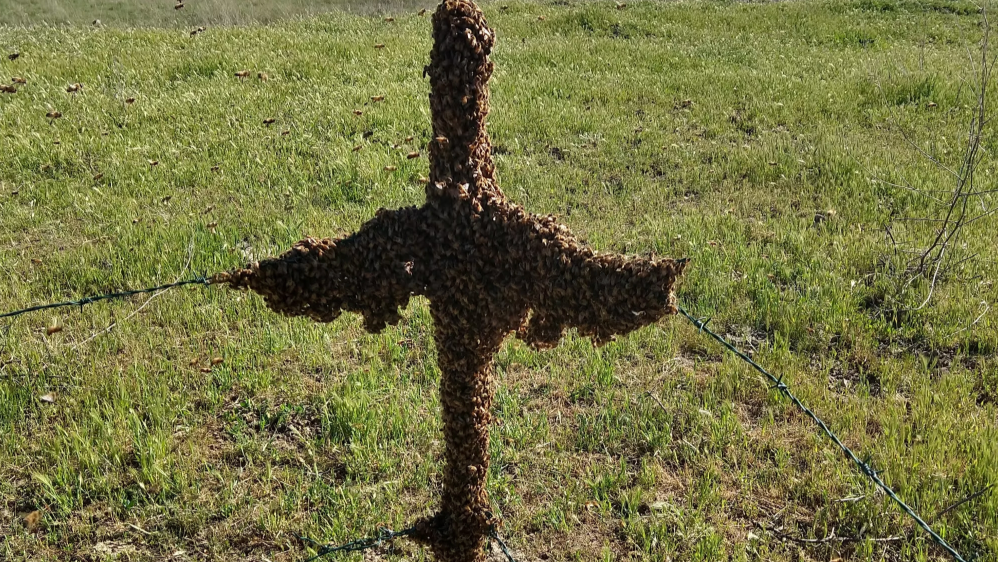Items Needed This Month
-
2-4 Gallons of 1:1 syrup (stimulates brood build up) depends on strength of hive and foraging
-
OAE mite treatment
-
2nd deep box (new hives)
-
Double Screen Board (swarm management)
Items Needed Next Month
-
1:1 Syrup (stimulates brood build up) optional for smaller hives
-
3rd deep box (Honey Super)
-
Queen excluder (optional)
Action Items
Overwintered
-
Hive inspection every 14 days
-
Check for queen rightness(means you see eggs)
-
Brood status(is the queen laying a good pattern) and does the larvae look pearly white and wet.
-
Pollen and honey stores and that the hive is growing in size and numbers each inspection.
-
Remember to give them space by adding a box if they are close to or over 80% full.
-
Feed syrup 1:1 (by volume, ratio: 1 cup sugar to 1 cup water) every week to build wax and honey stores.
-
Swarm Control - Check for swarm cells or hatched queen cells, evidence of queen(you see eggs). Split hive into new equipment or create artificial swarm.
-
Apply Mite Treatment OAE (see mite treatment info tab)
-
Learn about Swarm Management for overwintered hives
-
Look at June Action Items to know what to plan for next month.
Newbees
-
Inspect your new hive at least every 10-14 days.
-
Check for eggs(means you have a queen)
-
Good brood pattern (brood are the developing bees)
-
Do they have pollen and honey stores? (give them pollen supplement if needed)
-
Make sure your hive is growing each time your inspect.
-
Feed syrup 1:1 (by volume, 1 cup sugar to 1 cup water) every week to build wax and honey stores.
-
Hive configuration
-
One deep box with close to half or more of the frames built out.
-
Add a second box when the first box is 80% built out. If you don't give them space then your hive will swarm.
-
After adding your second box, move your frame feeder to the second box outside position where it will stay the remainder of the year.
-
Open your entrance reducer to medium opening so the entrance isn't crowded but still small enough for the hive to defend themselves.
-
Find a mentor who has had success overwintering their hive(s) preferably for at least 5 years.
-
Look at June Action Items to know what to plan for next month.
Mite Treatments
-
OAE - Place the two sponge treatment between the first and second brood boxes on top of the frames with 1-2 inch space between. This is a 45 day treatment that stays in the hive, but can be moved while doing inspections if needed.
I had an interesting phone call the other day from a new beekeeper whose bees were coming out of his hive getting ready to swarm. He wanted to know what he should do. I told him to, pull up a lawn chair and watch one of the amazing miracles of mother nature. The creation of a new hive. Try to relax and enjoy the learning experience that few people (other than beekeepers) get to witness. It seems like caos and no method to their madness. But soon the beauty of their organization starts to gel. It is fascinating to watch happen and sad if watch them spin up and fly away to their new home. Once a hive has started swarming you can't stop it from happening.

Swarm season has begun in earnest. It is always best to preempt swarming before they are preparing for it (as discussed last month). But, when a hive has started developing swarm queen cells. Usually along the bottom of frames but also at the bottom any developed comb.any where on a frame (indicating they want to and are planning on swarming). Aggressive action is required. One such method is to do a "Walk A way split". You are dividing the hive (without having to find the queen) and moving her into a hive in a new location next to the existing hive. Here are the steps to accomplish this.
Walk-Away Split:
The original Hive we will call hive "A" and the new hive we are going to make is hive"B". This should be done around 10 am (during the morning hours) if possible (explanation in step 4).
Step 1: Set up Hive B with the entrance at a 90 degree angle different from the entrance of Hive A.
Step 2: Put an empty deep box at Hive B and then start going through Hive A. You want to divide the hives' resources by putting an equal number of frames of honey, pollen, and brood (with both eggs, open larvae, and capped brood) in each box with the bees that were on those frames (don't shake the bees off).
Step 3: Take the frames from Hive A and shake all the bees off into Hive B and return them to Hive A. When you're done, all the bees will be in Hive B - no bees will be in Hive A.
Step 4: Make sure feeders are in both hives and fill them with liquid syrup. Put the lids on and entrance reducers. Over the next several hours (this is why you should do this at 10am so the bees have enough time to repopulate Hive A before it gets dark), the foraging bees that have been away, and/or leave hive B, gathering and working will return to Hive A because that is where they are oriented to. The house bees that aren't flying will remain in Hive B. By the next day you'll end up with a pretty equal population of bees in both hives.
Step 5: Decide whether to let the new hive raise a queen (that will take about 25-26 days before she will be laying her own eggs) or buy a mated queen and put her cage in the hive to be released by the worker bees in a couple of days. If there are capped swarm queen cells you can leave 2 of the biggest nicest looking ones in Hive A to hatch and they will start laying 14-21 days later depending on how far along in the development process (Take care to not damage the queen cells when your moving them.).
Once you've checked both hives 5 days later to verify the queen is still laying eggs in Hive B and then you can add a second box. Wait to add a box to Hive A until your new queen has been released from her cage and is laying eggs (takes about 5-6 days with a 1 inch candy plug). If you're letting them raise a queen, then go ahead and add a box so they have somewhere to add nectar that they will bring in until, or the newly hatched queen is laying eggs.
So enjoy this time of explosive hive growth! This is perfect opportunity to take advantage and double your hives within a budget.
Action Items for this month:
1. Make an artificial swarm (split) to control where your swarm goes; into your own box!
2. Feed 1:1 sugar to water ratio, syrup to the smaller splits until you are adding your Honey super (now till the first part of June). Learn about supplements like Honey-Be-Healthy and Probiotic and decide whether to use in your feed.
3. Add a box or space as needed to the hive you started in April or May (once they have built comb on 80% your new comb, or are occupying 80% of the frames if already drawn comb.
4. Research and learn how to do a mite test and choose the method you prefer.
5. Do a Mite Test!! Make sure your mite-load is low as we start the month of June and treat as needed. You shouldn't have anything higher than a one mite count from a 300 bee sample. Treat in May if required. You'll want to wait to treat again until after your honey harvest in August.
6. Inspect your hive every 10-14 days keeping an eye out for swarm cells or indicators of a potential swarm (no eggs for example). Learn to read what your hive is trying to tell you. Listen and act accordingly. (The reason for 10-14 days is they can raise a queen in 16 days. Knowing about it before she hatches gives you choices. After she has hatched, they made your choice for you.
Stay Healthy everyone - and Happy Beekeeping from Homer's Honeybee!

